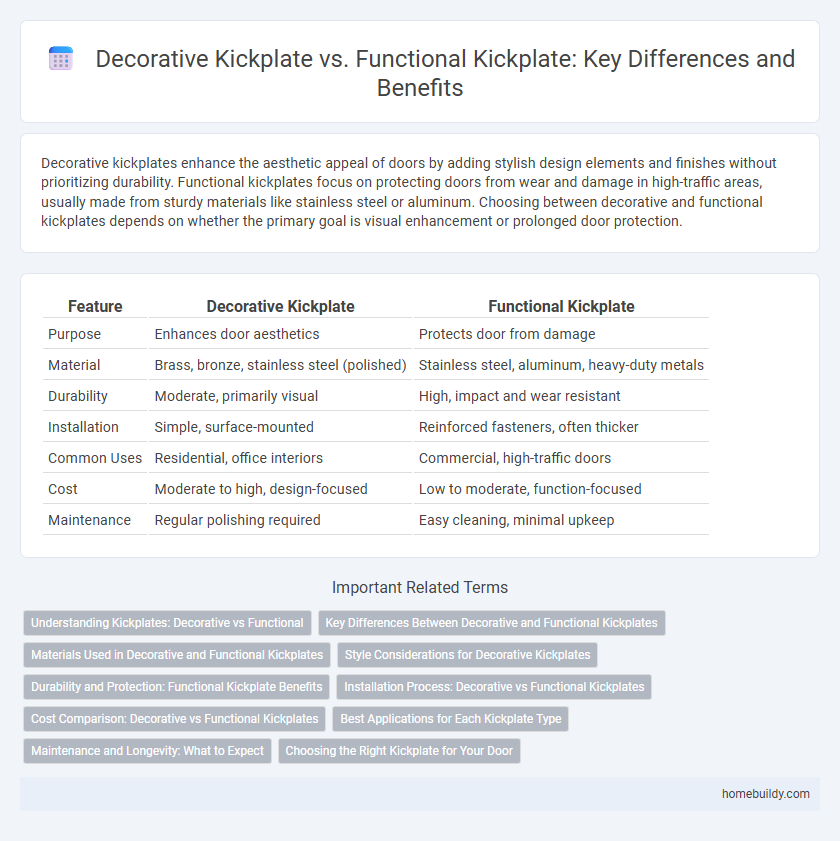Decorative kickplates enhance the aesthetic appeal of doors by adding stylish design elements and finishes without prioritizing durability. Functional kickplates focus on protecting doors from wear and damage in high-traffic areas, usually made from sturdy materials like stainless steel or aluminum. Choosing between decorative and functional kickplates depends on whether the primary goal is visual enhancement or prolonged door protection.
Table of Comparison
| Feature | Decorative Kickplate | Functional Kickplate |
|---|---|---|
| Purpose | Enhances door aesthetics | Protects door from damage |
| Material | Brass, bronze, stainless steel (polished) | Stainless steel, aluminum, heavy-duty metals |
| Durability | Moderate, primarily visual | High, impact and wear resistant |
| Installation | Simple, surface-mounted | Reinforced fasteners, often thicker |
| Common Uses | Residential, office interiors | Commercial, high-traffic doors |
| Cost | Moderate to high, design-focused | Low to moderate, function-focused |
| Maintenance | Regular polishing required | Easy cleaning, minimal upkeep |
Understanding Kickplates: Decorative vs Functional
Decorative kickplates enhance door aesthetics by offering stylish designs and finishes, often made from brass, stainless steel, or bronze to complement interior decor. Functional kickplates prioritize durability and protection, typically constructed from heavy-duty materials to shield doors from damage caused by kicks, scuffs, and wear in high-traffic areas. Selecting between decorative and functional kickplates depends on balancing design preferences with the need for robust door protection in commercial or residential settings.
Key Differences Between Decorative and Functional Kickplates
Decorative kickplates primarily enhance the aesthetic appeal of doors, featuring various finishes, patterns, and materials that complement interior design without necessarily adding durability. Functional kickplates are designed to protect doors from damage caused by kicks, scuffs, and wear, usually made from robust materials such as stainless steel or aluminum for maximum impact resistance. The key differences lie in their purpose, material strength, and design focus, with decorative kickplates prioritizing style and functional kickplates emphasizing durability and protection.
Materials Used in Decorative and Functional Kickplates
Decorative kickplates often utilize materials such as brass, aluminum, stainless steel, and copper, chosen for their aesthetic appeal and ability to complement various interior designs. Functional kickplates prioritize durability and protection, commonly made from heavy-gauge stainless steel, vinyl, or reinforced plastic to resist impact and wear. Both types use corrosion-resistant finishes, but functional kickplates emphasize strength and longevity, while decorative ones focus on enhancing door appearance with polished or brushed textures.
Style Considerations for Decorative Kickplates
Decorative kickplates enhance doors by combining protection with aesthetic appeal, featuring materials like brass, stainless steel, or ornate designs that complement interior styles. These kickplates prioritize visual impact, often customized with patterns or finishes to match architectural themes while still providing minor scuff resistance. Selecting a decorative kickplate involves balancing style elements with durability to ensure the door maintains both elegance and practical wear protection.
Durability and Protection: Functional Kickplate Benefits
Functional kickplates offer superior durability and protection compared to decorative kickplates, being designed to withstand frequent impact and prevent door damage in high-traffic areas. Made from robust materials such as stainless steel or aluminum, functional kickplates resist dents, scratches, and corrosion, extending the lifespan of doors. This protective quality is essential in commercial settings, where maintaining door integrity reduces maintenance costs and enhances safety.
Installation Process: Decorative vs Functional Kickplates
Decorative kickplates typically require simpler installation methods such as adhesive backing or basic screws, designed to enhance the aesthetic appeal without heavy-duty support. Functional kickplates, often made from metals like stainless steel or brass, demand more robust installation processes including precise measurements, drilling, and anchoring to withstand frequent impact and protect the door. Proper alignment and secure fastening are crucial in functional kickplate installation to ensure durability and effective door protection.
Cost Comparison: Decorative vs Functional Kickplates
Decorative kickplates typically cost between $20 and $80, offering aesthetic enhancements with materials like brass, stainless steel, or plastic, while functional kickplates range from $30 to $150, prioritizing durability and protection against door damage. Functional kickplates often use heavier gauge metals and reinforced designs, increasing material and installation expenses compared to decorative options. Budget considerations should balance the need for door protection with visual appeal, as functional kickplates provide long-term savings by reducing door repairs.
Best Applications for Each Kickplate Type
Decorative kickplates are ideal for enhancing aesthetic appeal in residential or commercial interiors where visual harmony is important, featuring materials like brass, stainless steel, or bronze to complement design themes. Functional kickplates are best suited for high-traffic areas such as office entrances, schools, and hospitals, providing durable protection against impact and wear with heavy-duty materials like aluminum or stainless steel. Choosing the right type depends on whether the priority is visual enhancement or robust door protection in demanding environments.
Maintenance and Longevity: What to Expect
Decorative kickplates, often made from lightweight materials like brass or stainless steel, require minimal maintenance but may show wear and scratches over time, reducing their aesthetic appeal. Functional kickplates, designed from heavy-duty materials such as aluminum or reinforced steel, offer enhanced durability and resistance to impact, extending the lifespan of both the door and the plate itself. Regular cleaning and occasional touch-ups can maximize the longevity of decorative kickplates, while functional kickplates generally need less frequent upkeep due to their robust construction.
Choosing the Right Kickplate for Your Door
Decorative kickplates enhance the aesthetic appeal of doors by offering a variety of materials, finishes, and designs tailored to interior styles, while functional kickplates prioritize durability and protection against scuffs, often made from heavy-duty metals like stainless steel or brass. Selecting the right kickplate involves evaluating the door's exposure to traffic, potential impact damage, and desired maintenance level, ensuring both visual harmony and practical resilience. For high-traffic areas, a robust functional kickplate extends door lifespan, whereas decorative options suit low-impact environments where style is paramount.
Decorative kickplate vs functional kickplate Infographic

 homebuildy.com
homebuildy.com